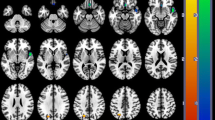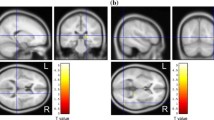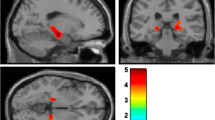Abstract
Purpose
Depression is a common symptom in patients suffering from Parkinson’s disease (PD) and markedly reduces their quality of life. As post-mortem studies have shown, its presence may reflect extensive cell loss in the midbrain and brainstem with imbalances in monoaminergic neurotransmitters. However, in vivo evidence of specific monoaminergic deficits in depressed PD patients is still sparse. Therefore, we studied PD patients with depression (PD+D) and without depression (PD−D) using high-resolution single-photon emission computed tomography (SPECT) and the monoamine transporter marker [123I]FP-CIT.
Methods
A magnetic resonance imaging-based region-of-interest analysis was applied to quantify the specific-to-nondisplaceable [123I]FP-CIT binding coefficient V3″ in the striatum, thalamus and midbrain/brainstem regions.
Results
PD+D patients had significantly lower V3″ compared with PD−D patients in the striatum (p<0.001), thalamus (p=0.002), and midbrain/brainstem (p=0.025). Only PD+D patients without selective serotonin reuptake inhibitor (SSRI) treatment showed lower thalamic and midbrain V3″ than controls (p<0.001, p=0.029). In a small sub-group of SSRI-treated PD+D patients neither thalamic V3″ nor midbrain/brainstem V3″ differed from those in PD−D patients (p=0.168, p=0.201) or controls (p=0.384, p=0.318).
Conclusion
Our data indicate that depression in PD is associated with a more pronounced loss of striatal dopamine transporter availability that is most likely secondary to increased dopaminergic degeneration. In addition, depressed PD patients have a lower availability of midbrain/brainstem monoamine transporters than nondepressed PD patients. These findings provide in vivo evidence in support of the known post-mortem data demonstrating more extensive nerve cell loss in PD with depression and indicate that SPECT imaging can help to identify pathophysiological changes underlying nonmotor symptoms in this common movement disorder.



Similar content being viewed by others
References
Lamberg L. Psychiatric symptoms common in neurological disorders. JAMA 2001;286:154–56.
Lemke MR, Fuchs G, Gemende I, Herting B, Oehlwein C, Reichmann H, et al. Depression and Parkinson’s disease. J Neurol 2004;251(Suppl 6):VI/24–VI/27.
Weintraub D, Stern MB. Psychiatric complications in Parkinson disease. Am J Geriatr Psychiatry 2005;13:844–51.
Brücke T, Djamshidian S, Bencsits G, Pirker W, Asenbaum S, Podreka I. SPECT and PET imaging of the dopaminergic system in Parkinson’s disease. J Neurol 2000;247(Suppl 4):IV/2–IV/7.
Cropley VL, Fujita M, Innis RB, Nathan PJ. Molecular imaging of the dopaminergic system and its association with human cognitive function. Biol Psychiatry 2006;59:898–907.
Chia LG, Cheng LJ, Chuo LJ, Cheng FC, Cu JS. Studies of dementia, depression, electrophysiology and cerebrospinal fluid monoamine metabolites in patients with Parkinson’s disease. J Neurol Sci 1995;133:73–8.
Chung TH, Deane KH, Ghazi-Noori S, Rickards H, Clarke CE. Systematic review of antidepressant therapies in Parkinson’s disease. Parkinsonism Relat Disord 2003;10:59–65.
Yamamoto M. Depression in Parkinson’s disease: its prevalence, diagnosis, and neurochemical background. J Neurol 2001;248(Suppl 3):III5–III11.
Becker T, Becker G, Seufert J, Hofmann E, Lange KW, Naumann M, et al. Parkinson’s disease and depression: evidence for an alteration of the basal limbic system detected by transcranial sonography. J Neurol Neurosurg Psychiatry 1997;63:590–96.
Mössner R, Schmitt A, Syagailo Y, Gerlach M, Riederer P, Lesch KP. The serotonin transporter in Alzheimer’s and Parkinson’s disease. J Neural Transm Suppl 2000:345–50.
Sawabini KA, Watts RL. Treatment of depression in Parkinson’s disease. Parkinsonism Relat Disord 2004;10(Suppl 1):S37–S41.
Wersinger C, Rusnak M, Sidhu A. Modulation of the trafficking of the human serotonin transporter by human alpha-synuclein. Eur J Neurosci 2006;24:55–64.
Scholtissen B, Verhey FR, Steinbusch HW, Leentjens AF. Serotonergic mechanisms in Parkinson’s disease: opposing results from preclinical and clinical data. J Neural Transm 2006;113:59–73.
Brooks DJ, Piccini P. Imaging in Parkinson’s disease: the role of monoamines in behavior. Biol Psychiatry 2006;59:908–18.
Murai T, Müller U, Werheid K, Sorger D, Reuter M, Becker T, et al. In vivo evidence for differential association of striatal dopamine and midbrain serotonin systems with neuropsychiatric symptoms in Parkinson’s disease. J Neuropsychiatry Clin Neurosci 2001;13:222–28.
Hesse S, Barthel H, Schwarz J, Sabri O, Müller U. Advances in in vivo imaging of serotonergic neurons in neuropsychiatric disorders. Neurosci Biobehav Rev 2004;28:547–63.
Neumeyer JL, Tamagnan G, Wang S, Gao Y, Milius RA, Kula NS, et al. N-substituted analogs of 2β-carbomethoxy-3β-(4′-iodophenyl)tropane (β-CIT) with selective affinity to dopamine or serotonin transporters in rat forebrain. J Med Chem 1996;39:543–48.
Okada T, Fujita M, Shimada S, Sato K, Schloss P, Watanabe Y, et al. Assessment of affinities of β-CIT, β-CIT-FE, and β-CIT-FP for monoamine transporters permanently expressed in cell lines. Nucl Med Biol 1998;25:53–8.
Gu XH, Zong R, Kula NS, Baldessarini RJ, Neumeyer JL. Synthesis and biological evaluation of a series of novel N- or O-fluoroalkyl derivatives of tropane: potential positron emission tomography (PET) imaging agents for the dopamine transporter. Bioorg Med Chem Lett 2001;11:3049–53.
Olivier B, Soudijn W, van Wijngaarden I. Serotonin, dopamine and norepinephrine transporters in the central nervous system and their inhibitors. Prog Drug Res 2000;54:59–119.
Meyer PT, Sattler B, Lincke T, Seese A, Sabri O. Investigating dopaminergic neurotransmission with 123I-FP-CIT SPECT: comparability of modern SPECT systems. J Nucl Med 2003;44:839–45.
Booij J, de Jong J, de Bruin K, Knol R, de Win MM, van Eck-Smit BL. Quantification of striatal dopamine transporters with 123I-FP-CIT SPECT is influenced by the selective serotonin reuptake inhibitor paroxetine: a double-blind, placebo-controlled, crossover study in healthy control subjects. J Nucl Med 2007;48:359–66.
Hughes AJ, Daniel SE, Kilford L, Lees AJ. Accuracy of clinical diagnosis of idiopathic Parkinson’s disease: a clinico-pathological study of 100 cases. J Neurol Neurosurg Psychiatry 1993;55:181–84.
American Psychiatric Association. Diagnostic and statistical manual of mental disorders. 4th ed. Washington, DC: American Psychiatric Association; 1995.
Miyasaki JM, Shannon K, Voon V, Ravina B, Kleiner-Fisman G, Anderson K, et al.; Quality Standards Subcommittee of the American Academy of Neurology. Practice Parameter: evaluation and treatment of depression, psychosis, and dementia in Parkinson disease (an evidence-based review): report of the Quality Standards Subcommittee of the American Academy of Neurology. Neurology 2006;66:996–1002.
Sheikh JI, Yesavage JA. Geriatric Depression Scale (GDS): recent evidence and development of a shorter version. In: Brink TL, editor. Clinical gerontology: a guide to assessment and intervention. New York: The Haworth Press; 1986. p. 165–73
Barthel H, Müller U, Wächter T, Slomka P, Dannenberg C, Murai T, et al. Multimodal SPECT and MRT imaging data analysis for an improvement in the diagnosis of idiopathic Parkinson’s syndrome (in German). Radiologe 2000;40:863–69.
Hesse S, Oehlwein C, Barthel H, Schwarz J, Polster D, Wagner A, et al. Possible impact of dopamine SPECT on decision-making for drug treatment in Parkinsonian syndrome. J Neural Transm 2006;113:1177–90.
Hesse S, Barthel H, Murai T, Müller U, Müller D, Seese A, et al. Is correction for age necessary in neuroimaging studies of the central serotonin transporter? Eur J Nucl Med Mol Imaging 2003;30:427–30.
Lavalaye J, Booij J, Reneman L, Habraken JB, van Royen EA. Effect of age and gender on dopamine transporter imaging with [123I]FP-CIT SPET in healthy volunteers. Eur J Nucl Med 2000;27:867–69.
Weintraub D, Moberg PJ, Duda JE, Katz IR, Stern MB. Effect of psychiatric and other non-motor symptoms on disability in Parkinson’ disease. J Am Geriatr Soc 2004;52:784–88.
Holroyd S, Currie LJ, Wooten F. Depression is associated with impairment of ADL, not motor function in Parkinson disease. Neurology 2005;64:2134–35.
Meyer JH, Kruger S, Wilson AA, Christensen BK, Goulding VS, Schaffer A, et al. Lower dopamine transporter binding potential in striatum during depression. Neuroreport 2001;12:4121–25.
Hesse S, Schwarz J, Polster D, Strecker K, Sabri O. Dopaminergic hypofunction in parkinsonian patients with neuropsychiatric symptoms exceeds the degeneration of nigrostriatal neurons as expected by their motor impairment. Eur J Nucl Med Mol Imaging 2004;31(Suppl 2):S228.
Hesse S, Schwarz J, Polster D, Isaias IU, Peschel S, Wagner A, et al. Schweregrad und Symmetrie der nigrostriatalen dopaminergen Neurodegeneration kennzeichnen neuropsychiatrische Symptome bei Parkinson-Patienten. Nuklearmedizin 2004;43:A82.
Isaias IU, Hesse S, Benti R, Zini M, Schwarz J, Antonini A. Relationship between non-motor signs and asymmetry of striatal transporter (DAT) loss in patients with early Parkinson’s disease measured with SPECT and (123I)Ioflupane. Mov Disord 2005;20(Suppl 10):P142.
Hesse S, Schwarz J, Oehlwein C, Tietze F, Lincke T, Eggers B, et al. Different patterns of dopaminergic nerve cell degeneration in Parkinson’s disease. J Nucl Med 2003;44(Suppl):393.
Spiegel J, Hellwig D, Samnick S, Jost W, Möllers MO, Fassbender K, et al. Striatal FP-CIT uptake differs in the subtypes of early Parkinson’s disease. J Neural Transm 2007;114:331–35.
Hesse S, Lincke T, Hermann W, Oehlwein C, Tietze F, Schwarz J, et al. Asymmetry of presynaptic dopaminergic nerve cell degeneration is attributed to tremor-associated Parkinson’s disease (PD) but not to hypokinetic syndromes – an iodine-123-FP-CIT SPECT study. Eur J Nucl Med Mol Imaging 2003;30(Suppl):S156.
Hesse S, Schwarz J, Strecker K, Polster D, Isaias IU, Meixensberger J, et al. The severity of striatal dopaminergic hypofunction and the degree of neuropsychiatric impairment did not correlate with each other in parkinsonian patients. Eur J Nucl Med Mol Imaging 2004;31(Suppl 2):S373.
Isaias IU, Benti R, Cilia R, Canesi M, Marotta G, Gerundini P, et al. [123I]FP-CIT striatal binding in early Parkinson’s disease patients with tremor vs. akinetic-rigid onset. Neuroreport 2007;18:1499–1502.
Caretti V, Stoffers D, Winogrodzka A, Isaias IU, Costantino G, Pezzoli G, et al. Loss of thalamic serotonin transporters in early drug-naïve Parkinson’s disease patients is associated with tremor: an [123I]beta-CIT SPECT study. J Neural Transm 2008;115:721–29.
Weintraub D, Newberg AB, Cary MS, Siderowf AD, Moberg PJ, Kleiner-Fisman G, et al. Striatal dopamine transporter imaging correlates with anxiety and depression symptoms in Parkinson’s disease. J Nucl Med 2005;46:227–32.
Berding G, Brücke T, Odin P, Brooks DJ, Kolbe H, Gielow P, et al. [123I]β-CIT SPECT imaging of dopamine and serotonin transporters in Parkinson’s disease and multiple system atrophy. Nuklearmedizin 2003;42:31–38.
Kerenyi L, Ricaurte GA, Schretlen DJ, McCann U, Varga J, Mathews WB, et al. Positron emission tomography of striatal serotonin transporters in Parkinson disease. Arch Neurol 2003;60:1223–29.
Guttman M, Boileau I, Warsh J, Saint-Cyr JA, Ginovart N, McCluskey T, et al. Brain serotonin transporter binding in non-depressed patients with Parkinson’s disease. Eur J Neurol 2007;14:523–28.
Albin RL, Koeppe RA, Bohnen NI, Wernette K, Kilbourn MA, Frey KA. Spared caudal brainstem SERT binding in early Parkinson’s disease. J Cereb Blood Flow Metab 2008;28:441–44.
Parsey RV, Hastings RS, Oquendo MA, Huang YY, Simpson N, Arcement J, et al. Lower serotonin transporter binding potential in the human brain during major depressive episodes. Am J Psychiatry 2006;163:52–58.
Lehto S, Tolmunen T, Joensuu M, Saarinen PI, Vanninen R, Ahola P, et al. Midbrain binding of [123I]nor-β-CIT in atypical depression. Prog Neuropsychopharmacol Biol Psychiatry 2006;30:1251–55.
Rub U, Del Tredici K, Schultz C, Ghebremedhin E, de Vos RA, Jansen Steur E, et al. Parkinson’s disease: the thalamic components of the limbic loop are severely impaired by α-synuclein immunopositive inclusion body pathology. Neurobiol Aging 2002;23:245–54.
Nutt DJ. The role of dopamine and norepinephrine in depression and antidepressant treatment. Clin Psychiatry 2006;67(Suppl 6):3–8.
Remy P, Doder M, Lees A, Turjanski N, Brooks D. Depression in Parkinson’s disease: loss of dopamine and noradrenaline innervation in the limbic system. Brain 2005;128:1314–22.
Schrag A, Barone P, Brown RG, Leentjens AF, McDonald WM, Starkstein S, et al. Depression rating scales in Parkinson’s disease: critique and recommendations. Mov Disord 2007;22:1077–92.
Smith GS, Dewey SL, Brodie JD, Logan J, Vitkun SA, Simkowitz P, et al. Serotonergic modulation of dopamine measured with [11C]raclopride and PET in normal human subjects. Am J Psychiatry 1997;154:490–96.
Acknowledgements
We are grateful to Daniel Polster for his postgraduate work and support.
Conflicts of interest
The authors acknowledge GE Healthcare for supporting this study with a regular industry sponsorship and with a travel grant to S.H., H.B. and J.S. received honoraria from GE Healthcare for a company-related publication and for advisory activities regarding a company-related publication.
Author information
Authors and Affiliations
Corresponding author
Rights and permissions
About this article
Cite this article
Hesse, S., Meyer, P.M., Strecker, K. et al. Monoamine transporter availability in Parkinson’s disease patients with or without depression. Eur J Nucl Med Mol Imaging 36, 428–435 (2009). https://doi.org/10.1007/s00259-008-0979-7
Received:
Accepted:
Published:
Issue Date:
DOI: https://doi.org/10.1007/s00259-008-0979-7




